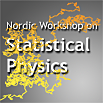Speaker
John Hertz
(Nordita)
Description
Ising models form a natural framework for modeling the
distribution of multi-neuron spike patterns: Of all models
that correctly describe the firing rates and pairwise firing
correlations, the Ising model is the one of maximum entropy.
The problem at hand here is an inverse one to that we
usually encounter. Normally, one has a model with given
couplings (Jij) and the task is to compute averages and
correlation functions of the variables of the model. Here
we are given the averages and correlations and the task is
to find the couplings.
In the simplest approach to this problem, one considers only
the measured firing rates and equal-time pairwise firing
correlations and tries to find the Ising model that has
these statistics. In our work we have explored and compared
a number of methods for doing this, using data from a
realistic model network of spiking neurons. Several of
these methods work remarkably well.
This success is tempered, however, by our second set of
findings. Using an information-theoretic measure of the
overall quality of fit, we find that, while the Ising model
is a good description of the distribution of spike patterns
for small populations of neurons (~ 10), it does worse and
worse for larger and larger populations (for reasons that
are not yet understood).
Finally, I will describe some recent work, which extends the
Ising approach to describe non-equal-time firing correlations.

